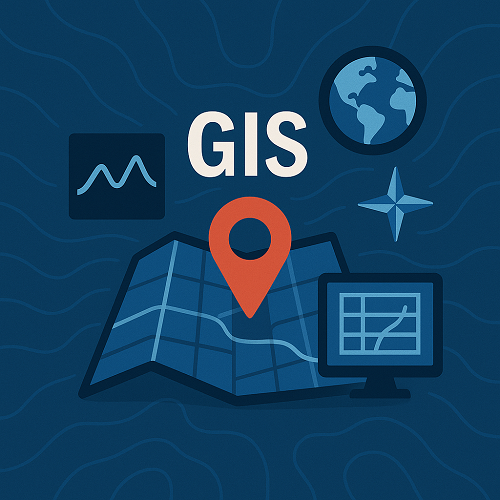TL;DR
- Artificial Intelligence and GIS integration is enabling faster, more accurate spatial analysis.
- Real-time analytics in GIS supports proactive decision-making for smart cities and disaster response.
- Blockchain is being applied for secure, verifiable geospatial data management.
- Virtual Reality integration is adding immersive spatial data visualization for planning and design.
- Mobile mapping technologies are advancing, enabling high-precision data collection in the field.
What’s New Right Now
The GIS industry in 2025 continues to see rapid transformation driven by cross-technology adoption. Artificial Intelligence (AI) is streamlining spatial data classification and predictive modeling (source). Real-time analytics are being embedded directly into mapping applications, enabling time-sensitive sectors to make faster decisions on live data streams (source).
Blockchain for GIS is emerging as a secure solution to guarantee the provenance and immutability of geospatial datasets (source). Meanwhile, Virtual Reality integration is enabling immersive exploration of geographic models, and mobile mapping hardware/software is reaching new levels of accuracy and portability.
Why It Matters
For businesses, these advancements offer stronger intelligence for location-based marketing, logistics optimization, and infrastructure management. Governments can leverage improved GIS to support climate resilience planning, urban growth monitoring, and efficient allocation of public resources. Technically, the integration of AI and blockchain addresses key challenges in automation, accuracy, and data integrity—paving the way for more transparent and accountable spatial analytics processes.
Deep Dive into Key Trends
AI-Driven Spatial Intelligence
Machine learning algorithms now classify satellite imagery in near real-time, improving detection of land use changes, wildlife tracking, and transportation flow analytics. This cuts down manual intervention and scales to handle massive datasets from sensors and IoT devices.
Real-Time Geospatial Analytics
Real-time GIS enables continuous data ingestion from field sensors, drones, and connected vehicles. This allows utilities companies to predict equipment failures, and emergency services to dynamically allocate resources during events.
Blockchain for Geospatial Trust
By decentralizing and encrypting geospatial datasets, blockchain ensures that users can verify the integrity of the data source. This is particularly critical in land registry systems and cross-border environmental monitoring.
VR and Mobile Mapping
Virtual Reality adds a new dimension to stakeholder presentations—turning complex datasets into interactive 3D experiences. Advanced mobile mapping lets field crews achieve centimeter-level accuracy from lightweight devices, reducing costs and improving safety.
Comparison of Emerging GIS Technologies
| Technology | Primary Benefit | Use Case Example |
|---|---|---|
| AI Integration | Accelerated pattern recognition | Land cover classification from satellite images |
| Real-Time Analytics | Immediate situational awareness | Disaster response routing |
| Blockchain | Data integrity and security | Immutable land transaction records |
| Virtual Reality | Immersive visualization | Urban planning consultation |
| Mobile Mapping | Field data accuracy and speed | Infrastructure inspection |
Mini Case Study: Flood Risk Management
Problem: A coastal municipality faced repeated storm surge flooding but lacked accurate, up-to-date data for mitigation planning.
Approach: The city deployed mobile mapping systems to survey vulnerable zones, used AI-driven models to simulate flooding scenarios in real time, and stored data on a blockchain ledger for inter-agency trust.
Outcome: Updated zoning maps improved evacuation route planning, reducing average emergency response times by 18%. The verified dataset also attracted state funding for infrastructure upgrades.
Implementation Checklist
- Assess current GIS capabilities and identify integration gaps.
- Select AI models suited for specific spatial analysis tasks.
- Implement secure blockchain protocols for sensitive datasets.
- Adopt mobile mapping devices for faster, more accurate fieldwork.
- Integrate real-time data feeds from sensors and IoT networks.
- Train staff on VR-based spatial data visualization tools.
- Monitor KPIs such as processing speeds, data accuracy, and ROI.
FAQs
What is the main advantage of AI in GIS?
It automates complex spatial data analysis, reducing time and improving accuracy for large-scale datasets.
How does blockchain improve GIS data security?
Blockchain provides immutable records, ensuring the data cannot be tampered with once recorded.
Is Virtual Reality in GIS only for urban planning?
No, VR is also used in environmental studies, heritage site preservation, and training simulations.
Do real-time analytics require special hardware?
They can leverage cloud infrastructure and existing IoT devices, but may require optimized GIS software capable of streaming ingestion.
Can mobile mapping replace traditional surveying?
It can complement or in some cases replace certain surveying tasks, especially where speed is prioritized over micrometer precision.
What sectors benefit most from emerging GIS tech?
Urban planning, environmental management, logistics, disaster response, and utilities see strong benefits from these advancements.
Conclusion
GIS technologies are entering a new era of intelligence, security, and interactivity. From AI-enhanced analytics to blockchain-backed data governance, 2025 offers unprecedented opportunities to optimize spatial decision-making. Organizations ready to embrace these tools can gain a decisive advantage in solving complex location-based challenges. To learn more or explore tailored solutions, explore our GIS services.
